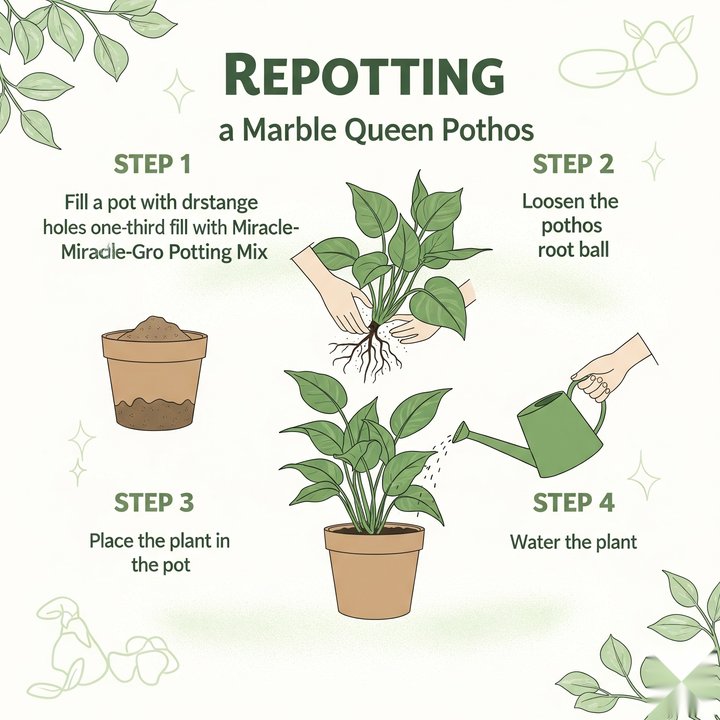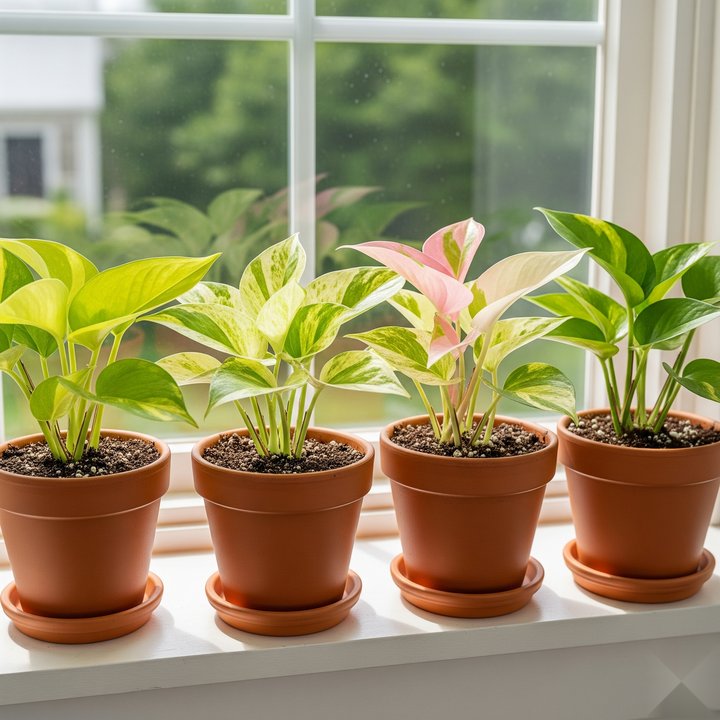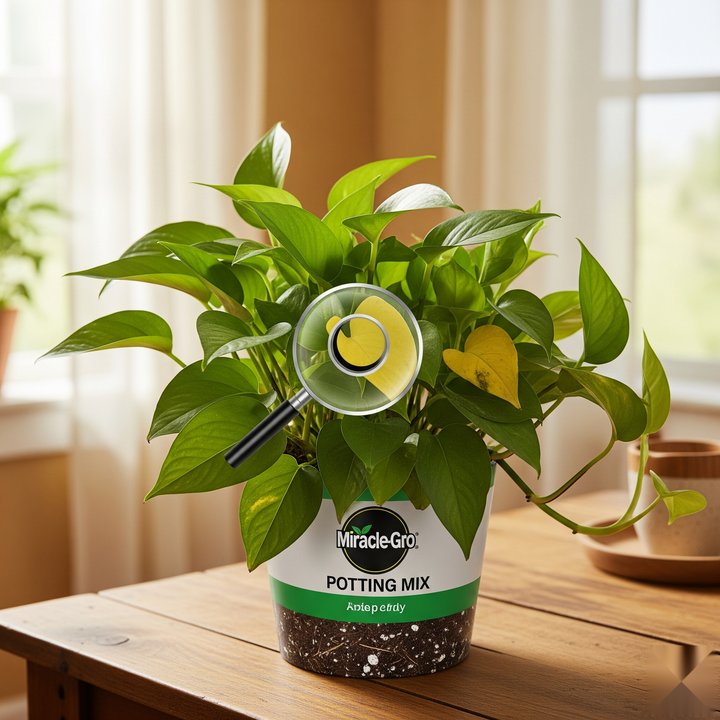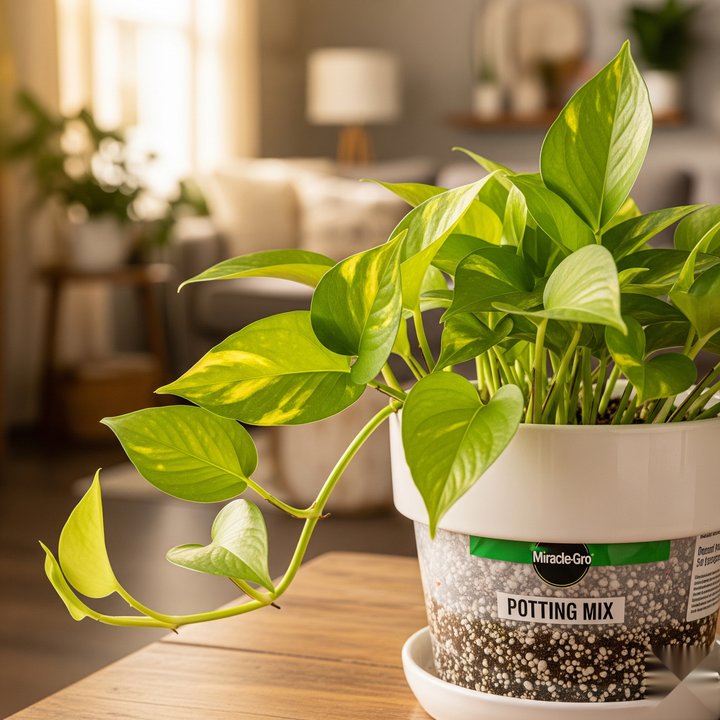Pothos plants, with their lush, heart-shaped leaves and easy-going nature, are a favorite among beginner and seasoned gardeners alike. If you’re wondering whether Miracle-Gro Potting Mix is a good choice for your pothos, you’re not alone. As someone who’s nurtured pothos plants for years—both in my cozy apartment and my outdoor patio—I’ve experimented with various potting mixes, including Miracle-Gro. This guide dives deep into whether Miracle-Gro Potting Mix suits pothos, covering its composition, benefits, potential drawbacks, and practical tips to ensure your pothos thrives. Whether you’re a first-time plant parent or a green thumb looking to optimize your pothos care, this post will equip you with everything you need to know.
Why Pothos Loves the Right Potting Mix
Pothos (Epipremnum aureum), often called devil’s ivy, is a forgiving houseplant that tolerates a range of conditions. However, its health hinges on a well-draining, nutrient-rich potting mix that mimics its natural tropical environment. A good mix supports its climbing or trailing vines, promotes healthy root growth, and prevents issues like root rot. Miracle-Gro Potting Mix is a popular choice due to its accessibility and promise of “growing plants twice as big.” But does it meet the specific needs of pothos? Let’s break it down.
What’s in Miracle-Gro Potting Mix?
Miracle-Gro Potting Mix is designed for container plants, both indoors and outdoors. Its composition includes:
- Processed forest products (like bark or wood chips) for structure.
- Sphagnum peat moss and coir for moisture retention and aeration.
- Perlite for drainage and to prevent soil compaction.
- A slow-release fertilizer (NPK ratio of 0.21-0.11-0.16) that feeds plants for up to 6 months.
- A wetting agent to help the mix absorb and retain water.
This blend aims to balance moisture, aeration, and nutrition, which sounds promising for pothos. In my experience, the mix feels light and fluffy out of the bag, making it easy to work with when repotting my marble queen pothos. However, the wetting agent and fertilizer components can be a double-edged sword, as we’ll explore later.
Is Miracle-Gro Potting Mix Good for Pothos?
The short answer: Yes, Miracle-Gro Potting Mix can work well for pothos, but it’s not perfect straight out of the bag. Pothos plants thrive in well-draining, slightly moist soil with moderate nutrients. Miracle-Gro’s general-purpose mix aligns with these needs, but its performance depends on how you use it and whether you address its potential pitfalls. Let’s dive into the pros, cons, and how to make it work for your pothos.
Benefits of Using Miracle-Gro Potting Mix for Pothos
- Convenient Nutrition: The slow-release fertilizer (0.21-0.11-0.16 NPK) provides a steady supply of nitrogen, phosphorus, and potassium for up to 6 months. This is great for pothos, which don’t need heavy feeding but benefit from consistent nutrients. In my neon pothos, I noticed vibrant leaf growth within weeks of repotting into fresh Miracle-Gro mix.
- Good Aeration: The inclusion of perlite and coir creates an airy texture, which supports pothos roots by preventing compaction. My golden pothos, potted in this mix, has developed strong, healthy roots without issues of suffocation.
- Widely Available: You can find Miracle-Gro at stores like Walmart, Home Depot, or even online in places like Sri Lanka via Desertcart. This accessibility makes it a go-to for beginners or anyone needing a quick solution.
- Versatility: It’s marketed for all container plants, so it’s suitable for pothos varieties like marble queen, jade, or neon, whether grown indoors or in a shaded outdoor area.
- Budget-Friendly: Compared to premium organic mixes, Miracle-Gro is affordable, making it ideal for those starting their plant journey on a budget.
Potential Drawbacks for Pothos
While Miracle-Gro has its strengths, some issues can affect pothos, especially if you’re not careful:
- Moisture Retention Issues: The wetting agent in Miracle-Gro is designed to hold moisture, but many users, including myself, have found it can keep the soil too wet for too long. Pothos prefer soil that dries out slightly between waterings, and overly moist conditions can lead to root rot. I once overwatered a pothos in this mix and noticed yellowing leaves—a classic sign of soggy roots.
- Fungus Gnats: A common complaint is fungus gnat infestations. These pests thrive in moist, organic-rich soil like Miracle-Gro. I’ve had to deal with gnats in my indoor pothos, especially when the soil stayed damp for weeks due to poor drainage in a pot without enough holes.
- Inconsistent Texture: Some bags contain large wood chips, sticks, or even debris like plastic bits, which can affect drainage and aesthetics. I’ve sifted through bags that felt more like mulch than potting soil, which wasn’t ideal for my delicate manjula pothos.
- Synthetic Fertilizers: The slow-release fertilizer is synthetic, which some gardeners worry may lead to salt buildup over time, potentially harming pothos roots if not flushed out periodically.
- Not Tailored for Indoor Use: While marketed as “all-purpose,” Miracle-Gro’s general mix may retain too much moisture for indoor pothos, especially in low-light or high-humidity environments. Their organic indoor mix might be a better fit, but it’s less common.
Tips for Using Miracle-Gro Potting Mix with Pothos

To make Miracle-Gro work for your pothos, follow these practical tips based on my experience and research:
- Amend the Mix: Pothos love well-draining soil. Mix in 20-30% extra perlite or orchid bark to improve drainage and counteract the wetting agent. I’ve found that adding perlite to Miracle-Gro creates a lighter mix that my pothos adore, reducing the risk of overwatering.
- Choose the Right Pot: Use a pot with drainage holes to prevent water from pooling. I learned this the hard way when I potted a pothos in a decorative pot without holes, leading to root rot. Terracotta pots are great for wicking away excess moisture.
- Water Carefully: Allow the top inch of soil to dry out before watering. Stick your finger in the soil or use a moisture meter to check. For my pothos, I water every 7-10 days indoors, but outdoor plants in hot weather may need more frequent checks.
- Sift for Debris: Before potting, sift through the mix to remove large wood chips or debris. This ensures a consistent texture and better root contact. I do this with a garden sieve, and it’s made a big difference in soil quality.
- Monitor for Pests: To prevent fungus gnats, let the soil dry out slightly between waterings and consider adding a layer of sand or gravel on top. I’ve also used sticky traps near my pothos to catch adult gnats before they lay eggs.
- Flush the Soil: Every few months, water thoroughly until water runs out the drainage holes to flush out excess salts from the fertilizer. This keeps the soil healthy for long-term pothos growth.
- Repot Annually: Pothos grow quickly, and their roots can outgrow the pot. Repot every 1-2 years with fresh Miracle-Gro mix to replenish nutrients and prevent compaction. I repotted my jade pothos last year, and it doubled in size afterward.
Variety-Specific Considerations for Pothos

Pothos come in various cultivars, each with slightly different needs. Here’s how Miracle-Gro suits popular varieties:
- Golden Pothos: This classic variety is hardy and tolerates Miracle-Gro’s nutrient profile well. Its fast growth benefits from the slow-release fertilizer, but watch for overwatering in low-light conditions.
- Marble Queen: With its variegated leaves, this variety needs bright, indirect light to maintain its pattern. Miracle-Gro’s aeration supports its roots, but I’ve found it needs extra perlite for drainage, especially indoors.
- Neon Pothos: Its bright chartreuse leaves love the nutrient boost from Miracle-Gro, but it’s sensitive to overwatering. Ensure excellent drainage to keep it thriving.
- Manjula Pothos: This delicate variety requires well-aerated soil. Amend Miracle-Gro with orchid bark to prevent compaction, as I did to keep my manjula’s roots happy.
Common Problems and Fixes with Miracle-Gro for Pothos

Even with a reliable mix like Miracle-Gro, pothos can face issues. Here are common problems and how to fix them:
- Problem: Yellowing Leaves
Cause: Often due to overwatering or poor drainage, leading to root rot.
Fix: Check the soil moisture and ensure the pot has drainage holes. Amend the mix with perlite and reduce watering frequency. I saved a yellowing pothos by repotting it into a better-draining mix and cutting back on water. - Problem: Fungus Gnats
Cause: Moist, organic-rich soil attracts gnats, especially if overwatered.
Fix: Let the soil dry out between waterings, add a top layer of sand, and use sticky traps. For severe infestations, I’ve microwaved small batches of soil (30 seconds per cup) to kill larvae before potting, though this is a last resort. - Problem: Stunted Growth
Cause: Compacted soil, nutrient depletion, or too much fertilizer causing salt buildup.
Fix: Repot with fresh mix, loosen the soil, and flush out salts. I noticed my pothos perked up after repotting and diluting the fertilizer with plain water. - Problem: Leaf Burn
Cause: Excess fertilizer salts or direct sunlight.
Fix: Flush the soil and reduce fertilizer use. Move the pothos to indirect light. I had leaf burn on a neon pothos placed too close to a sunny window, which resolved after relocating it. - Problem: Soil Hardening
Cause: Compaction over time, especially if the mix dries out completely.
Fix: Loosen the soil surface with a fork and add perlite or vermiculite. Water consistently to prevent drying out.
My Real-Life Experience with Miracle-Gro and Pothos
As a plant enthusiast, I’ve used Miracle-Gro Potting Mix for several pothos plants over the years. My golden pothos, which trails across my bookshelf, has thrived in this mix for two years with minimal fuss. The slow-release fertilizer keeps its leaves glossy, and I’ve only needed to repot once. However, my marble queen pothos struggled initially because I didn’t amend the mix, and the soil stayed too wet, causing a few yellow leaves. After adding perlite and switching to a terracotta pot, it bounced back beautifully. The biggest hassle was a fungus gnat outbreak last summer, likely from an overwatered pot left near an open window. Sticky traps and drier soil solved the issue. These experiences taught me that Miracle-Gro is a solid base, but tweaking it for pothos’ needs makes all the difference.
Alternatives to Miracle-Gro for Pothos
If Miracle-Gro’s drawbacks concern you, consider these alternatives:
- Espoma Organic Potting Mix: Ideal for organic enthusiasts, it offers great drainage and is less prone to gnats. I’ve used it for my manjula pothos with excellent results.
- FoxFarm Ocean Forest: This organic mix has better drainage than Miracle-Gro, perfect for pothos in humid climates. It’s pricier but worth it for sensitive varieties.
- DIY Mix: Combine 50% peat moss or coir, 30% perlite, and 20% orchid bark for a custom pothos mix. I’ve made this for my neon pothos, and it loves the airy texture.
Encouragement and Practical Advice
Caring for pothos is a rewarding journey, and Miracle-Gro Potting Mix can be a great starting point. Don’t be discouraged if you hit a snag—pothos are resilient, and a little tweaking can go a long way. Experiment with amending the mix, check your watering habits, and keep an eye on your plant’s signals (yellow leaves mean “help!”). With a bit of love, your pothos will reward you with cascading vines and vibrant foliage. If you’re new to gardening, start small, and soon you’ll be a pothos pro!
FAQ: Common Questions About Miracle-Gro and Pothos
Q: Can I use Miracle-Gro Potting Mix straight from the bag for pothos?
A: Yes, but it’s better to amend it with perlite or orchid bark to improve drainage, as pothos dislike soggy soil.
Q: How often should I water my pothos in Miracle-Gro mix?
A: Water when the top inch of soil feels dry, typically every 7-10 days indoors. Check with your finger or a moisture meter to avoid overwatering.
Q: Will Miracle-Gro cause fungus gnats in my pothos?
A: It can, especially if the soil stays too wet. Let the soil dry out slightly, use sticky traps, and ensure good drainage to prevent gnats.
Q: Is Miracle-Gro’s fertilizer safe for pothos?
A: Yes, the slow-release fertilizer is safe and supports growth, but flush the soil every few months to prevent salt buildup.
Q: Can I use Miracle-Gro for all pothos varieties?
A: Yes, it works for most varieties, but delicate ones like manjula may need extra drainage amendments to thrive.
By understanding Miracle-Gro’s strengths and limitations, you can make it work beautifully for your pothos. Happy planting!
References
- Miracle-Gro Potting Mix | Miracle Gro. Accessed July 13, 2025. https://miraclegro.com/…75678304.html
- Customer Reviews for Miracle-Gro Potting Mix – The Home Depot. Accessed July 13, 2025. https://www.homedepot.com/…
- Is Miracle Gro Potting Soil Any Good?? – Reddit. Accessed July 13, 2025. https://www.reddit.com/…
- 10 Reasons You Should Never Use Miracle-Gro – Gardenary. Accessed July 13, 2025. https://www.gardenary.com/…

